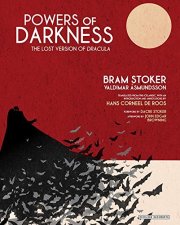Stefan Dziemianowicz reviews Powers of Darkness
Powers of Darkness: The Lost Version of Dracula, Bram Stoker & Valdimar Ásmundsson (Overlook Press 978-1-4683-1336-9, $29.95, 320pp, hc) December 2016.
 Question: When is Bram Stoker’s Dracula not Bram Stoker’s Dracula?
Question: When is Bram Stoker’s Dracula not Bram Stoker’s Dracula?
Answer: When it’s Makt Myrkranna, a book whose title translates from the Icelandic as Powers of Darkness and which, in the early twentieth century, was published as the Icelandic-language edition of Stoker’s vampire classic. This new edition of Powers of Darkness, translated into English and with annotations by Hans Corneel de Roos, is being presented as the ‘‘lost version’’ of Dracula: ‘‘lost’’ because its existence was largely unknown to all but the most entrenched Dracula scholars until only a few decades ago; and ‘‘version’’ because it is not a pure translation of Dracula as it is known to most readers but, possibly, an interpretation whose deviations from Stoker’s novel raise questions about the genesis of both books.
On the surface, the story of the novel’s publication seems fairly straightforward. In 1900 publisher Valdimar Ásmundsson serialized his translation of Dracula as Makt Myrkranna in his Reykjavík-based newspaper Fjallkonen, shortly in advance of the book’s hardcover publication the following year. Stoker even contributed a preface that ran with the first serial installment in which he touted the veracity of the story’s events and likened them to the ‘‘infamous murders by Jack the Ripper,’’ which, he indicates, happened some years after them. At least initially, Powers of Darkness reads faithful to its source. It employs the same epistolary format that distinguishes Dracula, recounting through diary entries the travels of ‘‘Thomas Harker’’ – a name change from ‘‘Jonathan Harker’’ that Stoker appears to have sanctioned, since he mentions Harker by the same name in his preface – to Castle Dracula, where he gradually realizes that he has become a prisoner whom the Count will dispose of once Harker has finalized the legal arrangements necessary for Dracula’s move to England. The three vampire maidens who seduce Harker during his stay have been condensed into a single female vampire femme fatale, but several scenes in the Icelandic version track closely with those of Stoker’s original, including the one in which Harker’s careless nick of his cheek while shaving drives Dracula to a frenzy of bloodlust, and the one where Dracula, upon hearing the baying of wolves, comments ‘‘Listen to them, the children of the night. What music they make’’ (rendered in Powers of Darkness as ‘‘the children of the night – what tuneful tones’’).
Serious differences between Powers of Darkness and Dracula begin about halfway in when Harker, prowling about the castle’s secret corridors during the Count’s nocturnal rambles, stumbles upon a subterranean chamber where Dracula is conducting a blood orgy replete with sacrificial women and scores of bestial supplicants who have ‘‘yellowish-brown frames, with muscular structures more like apes than humans.’’ The scene’s descriptions are the stuff of penny dreadfuls and they are exactly the sort of flamboyant luridness that Stoker refrained from indulging in his novel. Shortly after this, Harker runs across correspondence in Dracula’s library that suggests the count is conspiring with powerful figures throughout Europe to bring about a ‘‘great revolution’’ that will result in the oppression of the masses by the ‘‘chosen.’’ In Stoker’s original, of course, Dracula was entirely indifferent to human ambitions and interests, a solitary incarnation of a timeless and seemingly insuperable evil.
The most notable deviation between Powers of Darkness and Dracula, however, is in the portion of the novel set in the aftermath of Harker’s escape from the castle, as Dracula preys upon English society before being stopped by vampire-hunter Abraham Van Helsing and his small band of confederates. This constitutes the biggest chunk of Stoker’s novel and it has long been criticized as a lengthy and protracted denouement to the intense gothic horrors recounted in Harker’s earlier diary entries. In Powers of Darkness, these chapters are reduced to less than a quarter of the novel’s total length. The translation dispenses with the epistolary format altogether, introduces characters nowhere to be found in Stoker’s novel (seemingly for the purpose of rushing subplots along), and hastens events to an abrupt conclusion. It reads more like a Cliff Notes outline of Dracula than a well-plotted story in its own right.
It would be easy to dismiss Powers of Darkness as just a lackluster transcription of Stoker’s novel whose translator took significant liberties with its plot, but for the fact that it features plot elements outlined in a set of notes that Stoker prepared for Dracula that first surfaced in 1913, 16 years after the novel’s publication and one year after Stoker’s death. A number of these plot points do not appear Stoker’s final version of his novel, and this prompts the question of whether Powers of Darkness was, in fact, a translation of an early draft of Dracula. (It has long been speculated that the well-known short story ‘‘Dracula’s Guest’’, which Stoker’s widow Florence passed off as a chapter cut from the final novel is, in fact, an excerpt from an early draft of Dracula.) De Roos bolsters this supposition by pointing out that several characters in Powers of Darkness who do not appear in Dracula have names that echo those of people whom Stoker knew in real life. It is not clear how Ásmundsson would have gotten access to an early draft of Dracula, since Stoker is not known to have traveled to Iceland himself. But Stoker’s friend and fellow novelist Hall Caine – nicknamed ‘‘Hommy Beg’’ in Stoker’s dedication for Dracula – did, and both de Roos and Stoker’s great-grand-nephew Dacre Stoker (who provides a foreword to this edition) speculate that Caine may have helped to make the publication of Powers of Darkness possible.
This edition of Powers of Darkness raises more questions about Dracula than it answers. If it represents a translation into the Icelandic from an early draft of Dracula then, as Dacre Stoker posits, might it be worthwhile to study other early translations to see whether they too might have been made from early drafts – and what they might reveal about the process by which Stoker shaped his final text? And at what point between 1890 and 1897, the years that Stoker is known to have been working on Dracula, did he refine its text from the pulpy potboiler that Powers of Darkness suggests it might have started out as? We may never know the answers to these questions, and even if we did they would be irrelevant to our appreciation of Dracula and its translation. Powers of Darkness is an interesting artifact. It does not read well on its own merits; it flails and flounders in directions full of potential that it never quite capitalizes on. As a sidebar to Dracula, though, the ur-text for vampire fiction for more than a century and a foundation of the horror genre, it raises intriguing ‘‘what-if’’ possibilities.





